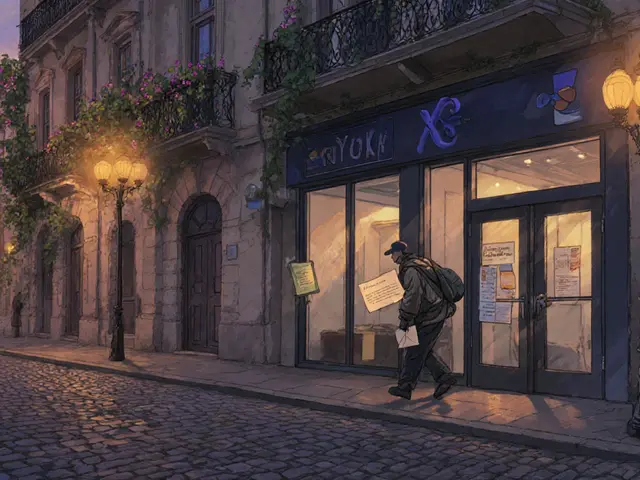31
Blockchain Prescription Drug Tracking: How It Stops Counterfeits and Saves Lives
Blockchain prescription drug tracking isn’t science fiction-it’s already being tested in real hospitals, stopping fake pills before they reach patients. Every year, millions of counterfeit drugs enter the global supply chain. Some contain no active ingredient. Others have deadly doses. Right now, tracing where a pill came from can take days, if it’s possible at all. But with blockchain, every step-from factory to pharmacy-is recorded instantly, securely, and permanently. No one can delete or alter it. And that changes everything.
Why the Current System Fails
Today’s drug supply chain is a maze of paper records, siloed databases, and manual checks. A prescription moves from doctor to pharmacy, then to insurer, then to patient. If something goes wrong-a batch is recalled, a drug is expired, or a fake pill slips in-finding the source is slow, messy, and often impossible. Pharmacies rely on barcode scans, but those can be faked. Systems don’t talk to each other. And when a controlled substance like oxycodone is prescribed, there’s no automatic update to state monitoring programs. That’s why prescription drug abuse continues to climb.The U.S. Drug Supply Chain Security Act (DSCSA) tried to fix this by 2023, but most companies still use fragmented systems. A pill might be scanned at the warehouse, then again at the distributor, but if the pharmacy skips the scan because the barcode is damaged? No one knows. That’s the gap blockchain fills.
How Blockchain Tracks Drugs Step by Step
Imagine every prescription drug has a digital twin. As it moves-from manufacturer to wholesaler to pharmacy to patient-each handoff is recorded as a block on a shared ledger. This isn’t a single company’s database. It’s a network where every participant (manufacturer, shipper, pharmacy, even the patient) sees the same, unchangeable record.Here’s how it works in practice:
- A drug package leaves the factory with a unique 2D barcode. This code links to its digital record on the blockchain.
- At every stop-warehouse, truck, pharmacy-the barcode is scanned. The system checks: Is this package real? Is it expired? Has it been recalled?
- If something’s wrong, the system flags it instantly. The package is quarantined before it reaches the patient.
- When the pharmacist dispenses the drug, the system automatically updates the state’s Prescription Drug Monitoring Program (PDMP). No manual entry. No delays.
- The patient gets a secure digital copy of their prescription history, encrypted and only accessible with their private key.
This isn’t theoretical. UCLA Health and LedgerDomain built BRUINchain as part of an FDA pilot. Using real-world data, they tracked drugs through the final, riskiest leg: from pharmacist to patient. The system scanned barcodes in under 50 milliseconds. It flagged expired meds, verified authenticity with manufacturers, and cut paperwork by 80%. No more chasing down faxed forms.
How It Stops Counterfeit Drugs
Counterfeit drugs are a global crisis. The WHO estimates 1 in 10 medical products in low- and middle-income countries are fake. Even in the U.S., fake opioids and antibiotics show up in online pharmacies. Traditional tracking can’t catch them because they often enter through unregulated channels.Blockchain changes that. Every legitimate product has a unique digital fingerprint tied to its barcode. If a fake pill enters the system, its barcode won’t match any record on the blockchain. The system rejects it before it’s even scanned at the pharmacy counter. And because the ledger is immutable, no one can delete the record of where that fake came from. Law enforcement can trace it back to the source.
One hospital in Arizona used BRUINchain’s prototype and blocked 17 fake batches of insulin in six months. Each one had a barcode that looked real-but the blockchain knew it wasn’t registered with the manufacturer. That’s the power of trustless verification.
Privacy and Patient Control
You might think: “If everyone can see my prescriptions, that’s a privacy risk.” But blockchain solutions like the Decentralized Medication Management System (DMMS) flip that idea. Your prescription data isn’t stored on a central server. It’s encrypted and split: the metadata (who prescribed it, when, what drug) goes on the blockchain. The actual prescription details go into a secure, decentralized file system called IPFS.Only you hold the key to unlock it. When you walk into the pharmacy, the pharmacist requests access. You approve it on your phone. The system decrypts your record and confirms the prescription is valid. No one else-not the insurer, not the doctor, not the pharmacy-can see your full history without your permission.
This isn’t just about privacy. It’s about control. Patients who are on long-term pain medication can now manage who sees their records. No more stigma. No more being treated like a suspect just because you need opioids.
Smart Contracts Automate Compliance
Regulations like DSCSA require detailed reporting. Pharmacies must log every dispensed controlled substance. Providers must report adverse reactions. Right now, it’s all manual. Forms get lost. Data gets entered wrong. Or not at all.Smart contracts-self-executing code on the blockchain-change that. When a drug is dispensed, the system automatically triggers a report to the PDMP. If a patient receives a new prescription for a controlled substance, the system checks their history and flags potential overuse. If a manufacturer ships a batch without proper serialization, the contract blocks the transaction.
No paperwork. No delays. No human error. And because everything is recorded on the blockchain, auditors can verify compliance in seconds, not weeks.
Challenges Still Standing in the Way
Blockchain isn’t magic. It has real hurdles.First, not every pharmacy has the hardware to scan barcodes quickly. Older systems still rely on manual entry. Upgrading costs money, and many small pharmacies can’t afford it.
Second, data standards are a mess. One manufacturer uses one barcode format. Another uses a different one. Until everyone agrees on the same rules, the system won’t work smoothly. The FDA is pushing for standardization, but progress is slow.
Third, energy use. Some blockchains (like Bitcoin’s) consume massive power. But newer ones-like the ones used in BRUINchain-use proof-of-authority or proof-of-stake, which need far less energy. These are designed for enterprise use, not mining.
Finally, legal gray areas. Who owns the data? Can insurers use it to deny coverage? Can employers access it? Laws haven’t caught up. Without clear regulations, adoption will stay limited.
What’s Next? The Road to Widespread Use
The technology is ready. The pilots work. The results are clear: fewer counterfeits, faster recalls, better monitoring, and more patient control.The next step is scaling. Health systems are starting to connect their internal records to blockchain networks. Insurers are testing how to use the data to prevent fraud. Governments are drafting laws to protect patient privacy while enabling transparency.
By 2027, most major U.S. pharmacies are expected to be fully integrated. Europe is following with similar regulations. The goal isn’t to replace doctors or pharmacists. It’s to give them tools that make their jobs safer and more accurate.
Imagine a future where you can scan a pill bottle with your phone and instantly see its entire journey: where it was made, who shipped it, when it passed inspection, and whether it’s been recalled. That’s not a dream. It’s the next normal.
Frequently Asked Questions
How does blockchain prevent fake prescription drugs from being sold?
Each legitimate drug package has a unique digital identifier tied to its barcode. When scanned, the blockchain checks if that ID was issued by the manufacturer and hasn’t been altered. If it’s not on the ledger-or if it’s been flagged as recalled or expired-the system blocks it before it reaches the patient. Fake drugs can’t be verified because they don’t have a valid digital record.
Can patients see their own prescription history on the blockchain?
Yes, but only with their permission. Patient data is encrypted and stored separately from the blockchain. Patients control access using a private key. They can grant temporary access to their pharmacy, doctor, or caregiver. No one else can view their records without explicit approval.
Is blockchain better than current electronic prescription systems?
Yes, in three key ways. First, it’s tamper-proof-no one can alter a prescription after it’s recorded. Second, it’s decentralized, so there’s no single point of failure. Third, it automatically updates drug monitoring programs when prescriptions are filled, reducing abuse. Traditional e-prescription systems still rely on centralized databases that can be hacked or corrupted.
Does blockchain track all medications or just controlled substances?
It can track all medications, but most pilot programs focus on controlled substances first-like opioids, benzodiazepines, and stimulants-because they pose the highest risk of abuse and counterfeiting. Once the system proves reliable for these, it expands to antibiotics, insulin, and other high-value drugs.
Why hasn’t this been adopted everywhere yet?
Three main reasons: cost, standardization, and regulation. Upgrading scanning equipment and software costs money, especially for small pharmacies. Different manufacturers use different barcode formats, making integration hard. And laws around data ownership and privacy haven’t fully caught up. But pilot programs are proving it works-and pressure is growing to scale it up.








Bruce Bynum
November 1, 2025 AT 00:03This is actually huge. Imagine walking into a pharmacy and knowing your meds are legit without having to question it. No more scary stories about fake opioids. This could save so many lives.
bob marley
November 1, 2025 AT 20:53Oh great. Another blockchain solution that’ll cost $20 billion to implement and still leave 80% of rural pharmacies using fax machines. We don’t need a digital ledger, we need people who can read barcodes.
Jeremy Jaramillo
November 2, 2025 AT 15:29I’ve seen this work firsthand in a pilot program. The speed of verification is insane. One scan, 50 milliseconds, and the system knows if it’s real or not. No more waiting days for a recall notice. This isn’t just tech-it’s safety.
Sammy Krigs
November 3, 2025 AT 06:08wait so u r saying a barcode can stop fake drugs? like… how? what if someone just prints a new barcode? blockchain dont fix stupid people
naveen kumar
November 3, 2025 AT 20:36Blockchain? So now the government and Big Pharma will have a tamper-proof record of every pill you take. Next they’ll track your sleep, your bowel movements, your Spotify playlist. This isn’t security-it’s surveillance dressed up as innovation.